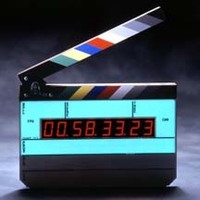 A master angle is usually shot, covering the entire song. After that, only selected portions of the song will be played back in order to get good close-ups and inserts. Only a brief lead-in of the music will play to allow the musicians to get into the rhythm, continued by the section that the Director needs to film.
A master angle is usually shot, covering the entire song. After that, only selected portions of the song will be played back in order to get good close-ups and inserts. Only a brief lead-in of the music will play to allow the musicians to get into the rhythm, continued by the section that the Director needs to film.
Although not recommended by professionals, it is possible to shoot a music video in VIDEO without timecode, since audio can be recorded in the camera. In this case, the camera would hear (either through a mic or a direct connection to the playback device) the section of music being played back. Later, the editor would just have to manually line up the audio on the video against the master soundtrack. It is not as fast as doing it with matching timecode numbers, but it can be done. Note that the audio recorded on the camera is deleted from the edit as soon as the picture is aligned with the master soundtrack. Never try to make a music video by patching together audio snippets of the song, even if they were recorded clean onto the camera.
Editors Note: Recently, a new software program came onto the market known as Plural Eyes, by Singular Software. This program interfaces with many editing platforms, and utilizes the waveforms of audio tracks to function similarly to timecode for lining up a master soundtrack to the scratch audio tracks recorded onto the camcorders. This makes it easy for the "timecode deprived" videographer to sync up multiple cameras covering an event, or to shoot a music video! Won't help you if you are shooting sprocketed film, however.
Shooting a music video is a long and tedious process. It only takes one slip by one musician to screw up the lip sync, play to the exact note sync, of a take.
A short, two or three minute song can easily take days to shoot!
Now, back to the techie stuff…
If we are shooting in NTSC 29.97 frame video, then we only have to playback the music at its correct and original speed. The PLAYBACK DUPE is played back at the same speed that it was originally recorded at. Make the DUPE at 29.97, and play it back on the set in real time (29.97).
But if we are shooting with a motion picture camera, the situation gets a bit complicated. When film is transferred to video, it actually gets slowed down just a wee bit in order to compensate for the fact that film runs at 24fps (a whole number) and video runs at 29.97 (a mixed number). To make 24 into 30, we shoot some of the frames an extra time (known as the 3-2 pulldown).
The 3-2 pulldown works like this. Every 4th frame is printed (or scanned) twice. That gives us 6 extra frames, for a total of 30. Example: 1, 2, 3, 4, 4, 5, 6, 7, 8, 8, 9, 10, 11, 12, 12, 13, 14, 15, 16, 16, 17, 18, 19, 20, 20, 21, 22, 23, 24, 24.
But to make 30 into 29.97, the whole system has to slow down slightly (0.1% to be precise).
What this means is that picture will be running slightly faster on the set then it will be in video. So if the picture slows down during transfer, and the audio does not – picture will be out of sync with the audio. Musicians will be out of sync with their music!
To correct for this, we have to play the music back at exactly 0.1% faster on the set than the final song will be. This will make the musicians lip sync slightly faster, so that when the footage is slowed down, the slower lip syncing will now match perfectly with the EDIT MASTER original song.
Here is how we get the music to playback faster. Professional audio recorders used for filmmaking have the ability to pull-up their playback rates by 0.1%. Timecode that was originally 29.97 will now playback at the rate of 30.
If the audio recorder does not have the internal capability to change speed in this manner, then we manufacture our PLAYBACK DUPES so that they are now at the 30 frame rate (remember that our original music is 29.97). The speed-up or pull-up is done when we record the Dupes, so that our playback devices do not have to deal with speeding up what they play. The machines just think of it as a regular song to be played back. Timecode (at the 30 frame rate, because that is what we recorded when we made the special DUPES) is played back and fed to the timecode slate on the set, so that it can be photographed by the film camera.
